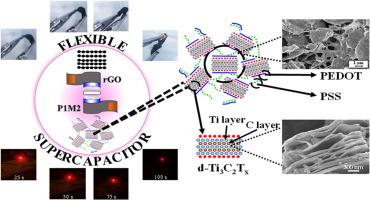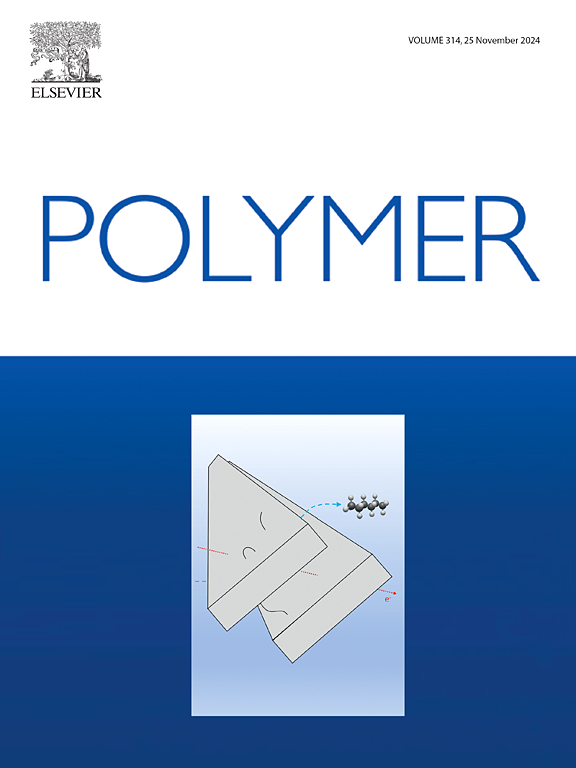High-performance flexible supercapacitor based on PEDOT:PSS wrapped delaminated Ti3C2Tx composite: experimental and DFT validation
IF 4.1
2区 化学
Q2 POLYMER SCIENCE
引用次数: 0
Abstract
Exploring new electrode materials with cyclic stability and energy storage capacity is crucial for high-performance energy storage in portable electronics. Herein, we present PEDOT:PSS (PP)/delaminated MXene (d-Ti3C2Tx) binary nanocomposites for electrode material for flexible supercapacitor (FSC). PP/d-Ti3C2Tx (1:2 weight ratio, P1M2) on activated carbon cloth results in an excellent specific capacitance of 718.67 F g-1 at a current density of 3.5 A g-1 in 1 M H2SO4. PEDOT chains wrap the d-Ti3C2Tx nanosheets by an opposite electrostatic interaction, while PSS chains act as web-like carrier pathways between two adjacent nanosheets. First principle DFT simulations demonstrate that charge storage in PEDOT:PSS@Ti3C2Tx is enhanced compared to PEDOT@Ti3C2Tx, which describes the effect of PSS chains in the composite. Computationally obtained absorption spectra align well with experimental results, validating the proposed morphology. To employ the P1M2 electrode for FSC, P1M2-P1M2 symmetric solid-state supercapacitor (SSC) and P1M2-rGO asymmetric solid-state supercapacitor (ASC) have been fabricated using 1 M PVA-H2SO4 gel electrolyte. P1M2-P1M2 SSC and P1M2-rGO ASC exhibit a high specific capacitance of 260.23 F g-1 (0.5 A g-1) and 176.46 F g-1 (0.1 A g-1) receptively. Larger potential window, excellent specific capacitance retention of ∼89% for 5000 GCD cycles, and great performance retention over the bending and twisting conditions make the ASC device a marvelous candidate for the portable energy storage device. The ASC device shows change in specific energy (specific power) from 35.29 W h kg-1 (240 W kg-1) to 26.22 W h kg-1 (1200 W kg-1). An assembly of three such ASC devices glows a red LED for ∼2 min.

基于 PEDOT:PSS 包裹分层 Ti3C2Tx 复合材料的高性能柔性超级电容器:实验和 DFT 验证
本文章由计算机程序翻译,如有差异,请以英文原文为准。
求助全文
约1分钟内获得全文
求助全文
来源期刊

Polymer
化学-高分子科学
CiteScore
7.90
自引率
8.70%
发文量
959
审稿时长
32 days
期刊介绍:
Polymer is an interdisciplinary journal dedicated to publishing innovative and significant advances in Polymer Physics, Chemistry and Technology. We welcome submissions on polymer hybrids, nanocomposites, characterisation and self-assembly. Polymer also publishes work on the technological application of polymers in energy and optoelectronics.
The main scope is covered but not limited to the following core areas:
Polymer Materials
Nanocomposites and hybrid nanomaterials
Polymer blends, films, fibres, networks and porous materials
Physical Characterization
Characterisation, modelling and simulation* of molecular and materials properties in bulk, solution, and thin films
Polymer Engineering
Advanced multiscale processing methods
Polymer Synthesis, Modification and Self-assembly
Including designer polymer architectures, mechanisms and kinetics, and supramolecular polymerization
Technological Applications
Polymers for energy generation and storage
Polymer membranes for separation technology
Polymers for opto- and microelectronics.
 求助内容:
求助内容: 应助结果提醒方式:
应助结果提醒方式:


